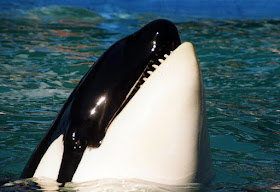Although Orca whales (Orcinus orca) almost never attack humans, they are frequently referred to as killer whales.In fact, "whale killer" was the original name of the killer whale.
The Whale and Dolphin Conservation (WDC) claims that ancient sailor sightings of them hunting in groups to catch large whales are to blame.Facts about orcas According to Live Science, the following are facts about orcas:
1.Orcas are the largest members of the dolphin family
in terms of body size.Male orcas are larger than females, but their weight and size vary by breed.9.8 meters in length and 10,000 kilograms in weight was the largest orca whale ever recorded.It is heavier and longer than the majority of motor homes.Orca whales are renowned for their black-and-white coloration and long dorsal fin.By blurring their outlines in the water, the black-and-white coloring aids orca whales in camouflage.A gray area located just behind its dorsal fin is referred to as the "saddle" due to its resemblance to a riding saddle.To create a hydrodynamic shape, the orca whale's body is cylindrical and tapered at each end.
The orca is one of the fastest marine mammals because of its shape and its enormous size and strength. It can reach speeds of more than 56 kilometers per hour.Additionally, orca whales have large teeth that can reach 10 centimeters in length.
2.Food for orca
whales Orca whales are the highest-ranking predators in the food chain.Other than humans, no other animals hunt orcas.Squid, seals, fish, seabirds, and a wide variety of other prey are consumed by these killer whales.Orcas are also capable of catching minke whales, which are larger than themselves.It has even been reported that killer whales kill swimming deer and deer.Orcas hunt their prey using a variety of methods.
Now and again, they head to the ocean side to get seals by bouncing from the water to the land.Orcas will also work together to catch larger groups of prey or schools of fish, among other things.
By making sounds or sound waves that travel through the water, they can use echolocation to identify their prey.The orca can use these waves to echo objects, such as prey, to locate its food.Orcas have never been known to kill humans in the wild.Humans are not part of their natural prey, so this is the reason.
However, orcas may occasionally mistake humans for seals or other animals they eat.At the Lofoten Masters surfing competition in Norway in 2017, a surfer was attacked by an orca whale that was caught on camera.However, before coming into contact, the orca appeared to be retreating from the attack.In a Facebook post, the Norwegian Orca survey said that the orca probably knew the surfer wasn't a seal.
A 12-year-old boy had been "run over" by a killer whale in 2005 near Ketchikan, Alaska.The failed attack on Norway is comparable to this event.
A surfer was bitten by an orca whale in California in the early 1970s, as reported by The Associated Press.The only instance of a wild orca actually biting a human is this one.Although wild killer whales rarely intentionally attack people, they frequently target boats.Since the summer of 2020, there have been numerous reports of orcas colliding with sailing vessels off the coasts of Spain and Portugal, causing damage.
3. Orca Whale Habitat
Other than humans and possibly the brown rat, the orca whale is the most common mammal.They inhabit every ocean in the world and have adapted to a variety of climates, including icy waters in the Arctic and South Pole and warm waters near the equator.Orca whales are likewise known to have the option to travel significant distances.For instance, a group of orcas traveled more than 1,900 kilometers in one study from Alaska's waters to near central California.
Orca whale species At the moment, all orca whales belong to one species, Orcinus orca.




Tidak ada komentar:
Posting Komentar
Berkomentar dengan kata-kata yang sopan